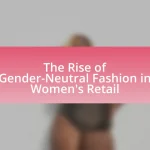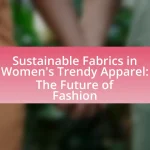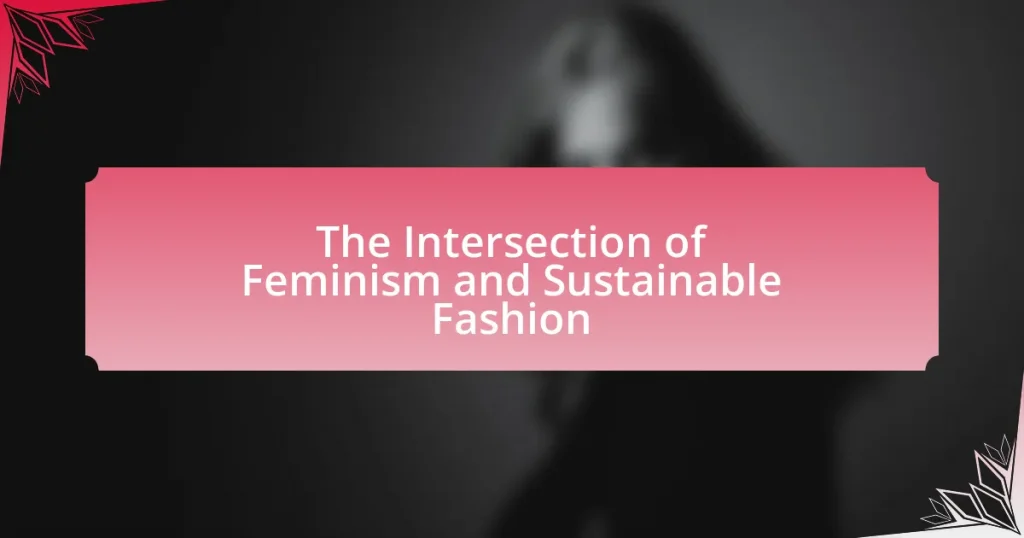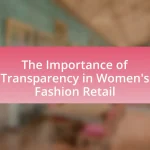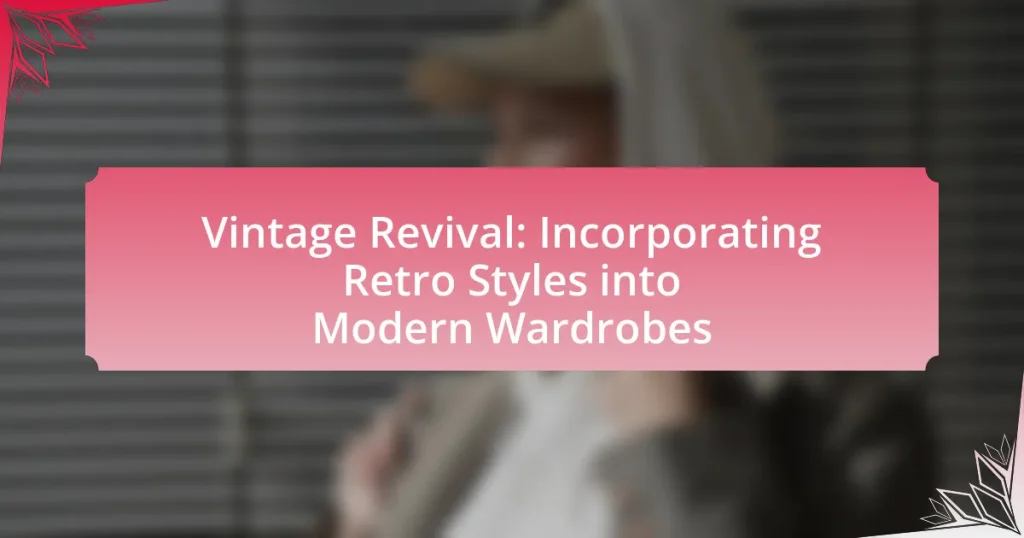The article explores the intersection of feminism and sustainable fashion, highlighting their shared goals of social equity and environmental responsibility. It discusses how feminism advocates for gender equality and the empowerment of women, while sustainable fashion emphasizes ethical labor practices and reducing environmental impact. Key topics include the importance of transparency in production processes, the challenges faced by women in the fashion industry, and the role of designers in promoting inclusivity and sustainability. Additionally, the article examines emerging movements and future trends that influence this intersection, emphasizing the need for collaboration and consumer support to foster a more equitable and sustainable fashion landscape.
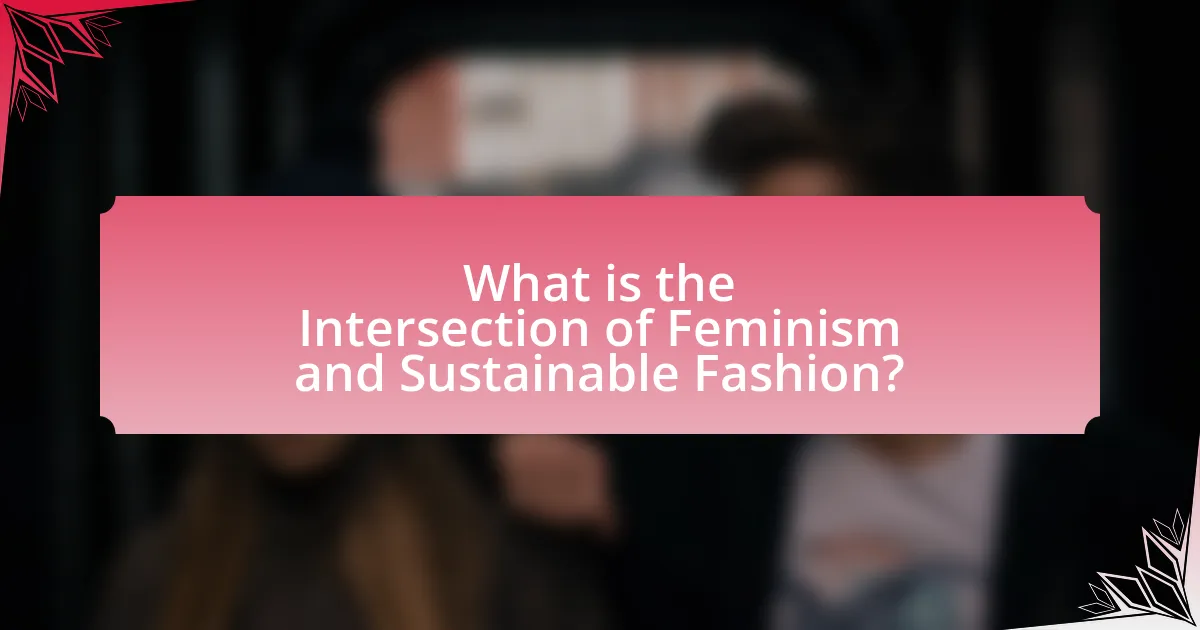
What is the Intersection of Feminism and Sustainable Fashion?
The intersection of feminism and sustainable fashion lies in the shared goals of promoting social equity and environmental responsibility. Feminism advocates for gender equality and the empowerment of women, while sustainable fashion seeks to reduce environmental impact and promote ethical labor practices. Both movements emphasize the importance of transparency in production processes, advocating for fair wages and safe working conditions for garment workers, many of whom are women. Research indicates that the fashion industry is one of the largest polluters globally, and addressing these issues through a feminist lens can lead to more inclusive and sustainable practices. For instance, the Fashion Revolution movement highlights the need for accountability in the fashion supply chain, aligning with feminist principles of justice and equity.
How do feminism and sustainable fashion relate to each other?
Feminism and sustainable fashion are interconnected through their shared focus on social justice, ethical labor practices, and environmental sustainability. Feminism advocates for the rights and empowerment of women, while sustainable fashion emphasizes responsible production methods that often prioritize fair labor conditions, which can benefit women in the garment industry. For instance, the fashion industry has been criticized for exploitative labor practices, particularly affecting women, who make up a significant portion of the workforce in garment production. By promoting sustainable fashion, advocates aim to create a more equitable industry that respects workers’ rights and addresses gender disparities. This relationship is further supported by initiatives that empower women through sustainable practices, such as cooperatives that provide fair wages and safe working conditions, illustrating the tangible benefits of aligning feminist principles with sustainable fashion efforts.
What are the core principles of feminism in the context of fashion?
The core principles of feminism in the context of fashion include empowerment, body positivity, inclusivity, and sustainability. Empowerment focuses on enabling women to express their identities and choices through fashion, challenging traditional gender norms. Body positivity promotes acceptance of diverse body types, encouraging brands to represent all women authentically. Inclusivity emphasizes the need for fashion to cater to women of all backgrounds, sizes, and abilities, ensuring equal access to style and self-expression. Sustainability aligns with feminist values by advocating for ethical production practices that respect women’s labor rights and the environment, highlighting the interconnectedness of social justice and ecological responsibility. These principles collectively aim to reshape the fashion industry into a more equitable and conscious space for all women.
How does sustainable fashion align with feminist values?
Sustainable fashion aligns with feminist values by promoting ethical labor practices and challenging gender inequality in the fashion industry. This alignment is evident as sustainable fashion prioritizes fair wages and safe working conditions, which directly supports the rights of women, who make up a significant portion of garment workers globally. According to the International Labour Organization, approximately 80% of garment workers are women, often facing exploitation and discrimination. By advocating for transparency and accountability in supply chains, sustainable fashion empowers women and fosters gender equity, reinforcing feminist principles of justice and equality.
Why is the intersection of feminism and sustainable fashion important?
The intersection of feminism and sustainable fashion is important because it promotes ethical practices that empower women while addressing environmental concerns. Sustainable fashion often emphasizes fair labor practices, which can uplift women in the garment industry, where they represent a significant portion of the workforce. According to the International Labour Organization, women make up 80% of the garment workforce globally, often facing exploitation and unsafe working conditions. By integrating feminist principles into sustainable fashion, the movement advocates for gender equality, fair wages, and safe working environments, thereby creating a more equitable industry. This intersection not only supports women’s rights but also fosters a more sustainable future for the planet.
What social issues are addressed by combining feminism and sustainable fashion?
Combining feminism and sustainable fashion addresses social issues such as gender inequality, labor rights, and environmental justice. Gender inequality is highlighted through the examination of how women, particularly in developing countries, are often exploited in the fast fashion industry, receiving low wages and working in poor conditions. Labor rights are emphasized as sustainable fashion advocates for fair wages and safe working environments, promoting ethical practices that empower female workers. Environmental justice is also a critical issue, as sustainable fashion seeks to reduce the ecological impact of clothing production, which disproportionately affects marginalized communities. These intersections illustrate the need for a holistic approach that considers both social and environmental dimensions in the fashion industry.
How can this intersection promote gender equality in the fashion industry?
The intersection of feminism and sustainable fashion can promote gender equality in the fashion industry by advocating for fair labor practices and empowering women in the supply chain. Sustainable fashion emphasizes ethical production, which often includes ensuring that female workers receive fair wages and safe working conditions. For instance, according to the Ethical Fashion Initiative, women make up 80% of the workforce in the fashion industry, yet they often face exploitation. By prioritizing sustainable practices, brands can support initiatives that uplift women, provide them with leadership opportunities, and promote their rights. This approach not only enhances gender equality but also fosters a more equitable industry overall.
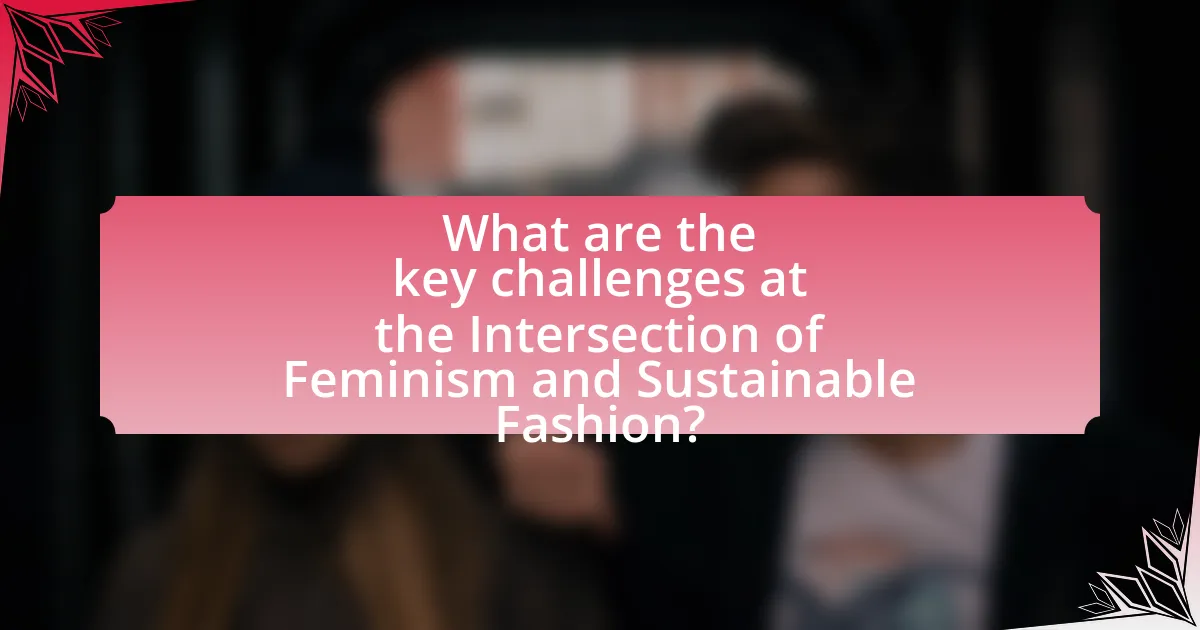
What are the key challenges at the Intersection of Feminism and Sustainable Fashion?
The key challenges at the intersection of feminism and sustainable fashion include the exploitation of female labor in garment production, the lack of representation of women in leadership roles within the fashion industry, and the tension between consumerism and ethical practices. The fashion industry often relies on low-wage female workers, particularly in developing countries, which raises ethical concerns about labor rights and gender equality. Furthermore, women are underrepresented in decision-making positions, limiting their influence on sustainable practices and policies. Additionally, the push for sustainable fashion can sometimes conflict with consumer culture, where the demand for fast fashion undermines the principles of sustainability and ethical consumption. These challenges highlight the need for a more inclusive and equitable approach to fashion that aligns feminist values with sustainable practices.
What barriers do women face in the sustainable fashion industry?
Women in the sustainable fashion industry face several barriers, including limited access to funding, gender bias, and lack of representation in leadership roles. These obstacles hinder their ability to innovate and influence the industry effectively. For instance, a report by McKinsey & Company highlights that women-led businesses receive only a fraction of venture capital funding compared to their male counterparts, which restricts their growth potential. Additionally, gender bias in decision-making processes often sidelines women’s contributions, while a study from the World Economic Forum indicates that women hold only 14% of executive positions in the fashion sector, limiting their impact on sustainability initiatives.
How do economic factors impact women’s roles in sustainable fashion?
Economic factors significantly influence women’s roles in sustainable fashion by shaping their access to resources, decision-making power, and opportunities for entrepreneurship. For instance, women often face barriers such as lower wages and limited access to capital, which can restrict their ability to invest in sustainable practices or start eco-friendly fashion businesses. According to the Global Gender Gap Report 2021 by the World Economic Forum, women globally earn about 68% of what men earn, which directly affects their financial independence and capacity to engage in sustainable fashion initiatives. Furthermore, economic incentives, such as government grants for sustainable businesses, can empower women to take leadership roles in this sector, promoting innovation and ethical practices. Thus, economic conditions play a crucial role in determining how women can participate and lead in the sustainable fashion movement.
What cultural perceptions hinder the growth of feminist sustainable fashion?
Cultural perceptions that hinder the growth of feminist sustainable fashion include the belief that sustainable fashion is primarily a luxury or niche market, which can alienate broader audiences. This perception is reinforced by the portrayal of sustainable brands as expensive and exclusive, limiting accessibility for many consumers. Additionally, traditional gender roles often associate femininity with fast fashion trends, leading to resistance against sustainable alternatives that may not conform to these expectations. Research indicates that societal norms around femininity and consumerism can create barriers, as women may feel pressured to prioritize style over sustainability. These cultural attitudes ultimately restrict the acceptance and growth of feminist sustainable fashion initiatives.
How can these challenges be overcome?
To overcome the challenges at the intersection of feminism and sustainable fashion, stakeholders must prioritize ethical labor practices and promote inclusivity in design processes. Implementing fair wages and safe working conditions for garment workers, particularly women, addresses economic disparities and empowers marginalized communities. Research by the Ethical Fashion Initiative indicates that ethical practices can enhance brand loyalty and consumer trust, demonstrating that sustainability and feminism can coexist profitably. Additionally, fostering collaboration between feminist organizations and sustainable fashion brands can lead to innovative solutions that amplify women’s voices in the industry, ensuring diverse representation and equitable opportunities.
What strategies can empower women in sustainable fashion?
Strategies that can empower women in sustainable fashion include promoting female entrepreneurship, providing access to education and training in sustainable practices, and fostering community networks. Female entrepreneurship can be supported through grants and mentorship programs, which have been shown to increase women’s participation in the fashion industry. Access to education, such as workshops on sustainable materials and ethical production methods, equips women with the skills needed to innovate and lead in this sector. Additionally, community networks facilitate collaboration and resource sharing, enhancing women’s visibility and influence in sustainable fashion initiatives. These strategies collectively contribute to a more equitable and sustainable fashion landscape.
How can collaboration between feminists and sustainable brands create change?
Collaboration between feminists and sustainable brands can create change by promoting ethical practices that empower women and support environmental sustainability. This partnership can lead to the development of products that prioritize fair labor practices, ensuring that women in the supply chain receive equitable wages and safe working conditions. For instance, brands like Reformation have integrated feminist principles by advocating for women’s rights while also committing to sustainable production methods, demonstrating that ethical fashion can align with social justice. Such collaborations can raise awareness about the importance of gender equality in the fashion industry, ultimately influencing consumer behavior and encouraging other brands to adopt similar practices.
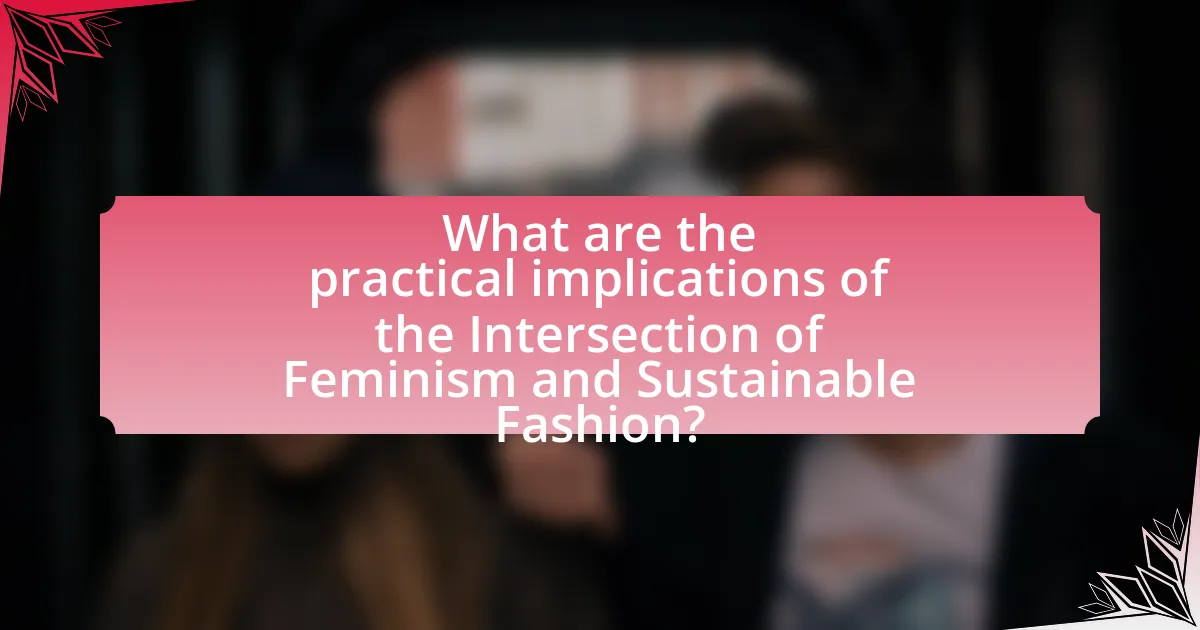
What are the practical implications of the Intersection of Feminism and Sustainable Fashion?
The practical implications of the intersection of feminism and sustainable fashion include promoting ethical labor practices, empowering women in the supply chain, and challenging traditional gender norms in fashion consumption. Ethical labor practices ensure fair wages and safe working conditions, which are crucial for women, who represent a significant portion of the garment workforce. Empowering women in the supply chain can lead to increased leadership roles and economic independence, as seen in initiatives like the Ethical Fashion Initiative, which connects marginalized women to global markets. Additionally, challenging traditional gender norms encourages consumers to rethink their purchasing habits, fostering a culture of sustainability that values quality over quantity, as evidenced by the rise of brands that prioritize both feminist values and eco-friendly practices.
How can consumers support feminist sustainable fashion initiatives?
Consumers can support feminist sustainable fashion initiatives by choosing to purchase from brands that prioritize ethical labor practices and promote gender equality. By selecting clothing from companies that are transparent about their supply chains and actively support women artisans and workers, consumers contribute to a more equitable fashion industry. Research indicates that brands like Reformation and Eileen Fisher not only focus on sustainability but also empower women through fair wages and leadership opportunities. Additionally, consumers can advocate for these initiatives by sharing information on social media, participating in campaigns that raise awareness about the importance of feminist principles in fashion, and supporting local women-owned businesses that align with sustainable practices.
What are the best practices for choosing sustainable and feminist brands?
To choose sustainable and feminist brands, prioritize companies that demonstrate transparency in their supply chains and ethical labor practices. Brands should provide clear information about their sourcing, production processes, and labor conditions, ensuring fair wages and safe working environments for all workers, particularly women. Research indicates that brands like Patagonia and Reformation have established strong commitments to sustainability and gender equality, showcasing their practices through certifications such as Fair Trade and B Corp status. Additionally, support brands that actively engage in community empowerment initiatives, such as those that invest in women’s education and leadership programs, further aligning with feminist values.
How can awareness campaigns influence consumer behavior towards sustainable fashion?
Awareness campaigns can significantly influence consumer behavior towards sustainable fashion by educating individuals about the environmental and social impacts of their clothing choices. These campaigns often highlight the negative consequences of fast fashion, such as pollution and labor exploitation, which can lead consumers to reconsider their purchasing habits. For instance, a study by the Global Fashion Agenda found that 66% of consumers are willing to pay more for sustainable brands when they are informed about the benefits of sustainable practices. By effectively communicating the importance of sustainability, awareness campaigns can shift consumer preferences towards brands that prioritize ethical production and eco-friendly materials.
What role do designers play in this intersection?
Designers play a crucial role in the intersection of feminism and sustainable fashion by creating clothing that embodies ethical practices and promotes gender equality. They are responsible for selecting sustainable materials, ensuring fair labor practices, and advocating for inclusivity in their designs. For instance, designers like Stella McCartney prioritize eco-friendly fabrics and ethical production methods, which align with feminist values of social responsibility and empowerment. This approach not only addresses environmental concerns but also challenges traditional fashion norms that often exploit marginalized communities. By integrating these principles, designers contribute to a fashion industry that supports both sustainability and women’s rights.
How can designers incorporate feminist principles into sustainable fashion designs?
Designers can incorporate feminist principles into sustainable fashion designs by prioritizing inclusivity, ethical labor practices, and environmental justice. By ensuring that their designs cater to diverse body types and cultural backgrounds, designers promote representation and challenge traditional beauty standards. Furthermore, adopting ethical labor practices, such as fair wages and safe working conditions for all workers, aligns with feminist values of equality and respect. Additionally, focusing on environmental justice addresses the disproportionate impact of fashion pollution on marginalized communities, reinforcing the connection between feminism and sustainability. This approach not only empowers women but also fosters a more equitable and responsible fashion industry.
What are some examples of successful feminist sustainable fashion brands?
Some examples of successful feminist sustainable fashion brands include Reformation, Eileen Fisher, and Mara Hoffman. Reformation focuses on eco-friendly materials and ethical labor practices while promoting body positivity and inclusivity. Eileen Fisher emphasizes sustainable practices and empowers women through initiatives like the Women’s Business Enterprise National Council. Mara Hoffman is known for its commitment to sustainable fabrics and ethical production, advocating for social justice and environmental responsibility. These brands exemplify the intersection of feminism and sustainable fashion by prioritizing both environmental sustainability and women’s empowerment.
What are the future trends at the Intersection of Feminism and Sustainable Fashion?
Future trends at the intersection of feminism and sustainable fashion include increased emphasis on ethical labor practices, body inclusivity, and eco-conscious materials. Ethical labor practices are gaining traction as brands prioritize fair wages and safe working conditions for women in the fashion supply chain, reflecting feminist values of equality and justice. Body inclusivity is becoming a focal point, with brands expanding size ranges and promoting diverse representations, aligning with feminist ideals of empowerment and self-acceptance. Additionally, the use of eco-conscious materials, such as organic cotton and recycled fabrics, is on the rise, as consumers demand transparency and sustainability, which resonates with both feminist and environmental movements. These trends are supported by research indicating that consumers increasingly prefer brands that align with their values, particularly regarding social justice and environmental responsibility.
How is technology shaping the future of feminist sustainable fashion?
Technology is shaping the future of feminist sustainable fashion by enabling innovative production methods, enhancing transparency in supply chains, and fostering community engagement. Advanced technologies such as 3D printing and digital textile printing allow for on-demand production, reducing waste and promoting ethical labor practices, which align with feminist values of equity and sustainability. Additionally, blockchain technology provides traceability, ensuring that consumers can verify the ethical sourcing of materials and labor conditions, thus empowering informed purchasing decisions. Furthermore, social media platforms facilitate grassroots movements and collaborations among feminist designers and consumers, amplifying voices that advocate for sustainable practices. These technological advancements collectively contribute to a more inclusive and environmentally conscious fashion industry.
What emerging movements are influencing this intersection?
Emerging movements influencing the intersection of feminism and sustainable fashion include the slow fashion movement, which advocates for ethical production practices and challenges fast fashion’s exploitative labor conditions. This movement emphasizes transparency, sustainability, and fair wages, aligning with feminist principles of social justice and equity. Additionally, the body positivity movement promotes inclusivity and diversity in fashion, encouraging brands to represent a wider range of body types and identities, which resonates with feminist ideals of empowerment and self-acceptance. Furthermore, the eco-feminism movement connects environmental sustainability with feminist activism, highlighting the relationship between the exploitation of women and the environment, thus advocating for a holistic approach to both issues. These movements collectively shape a more equitable and sustainable fashion landscape.





